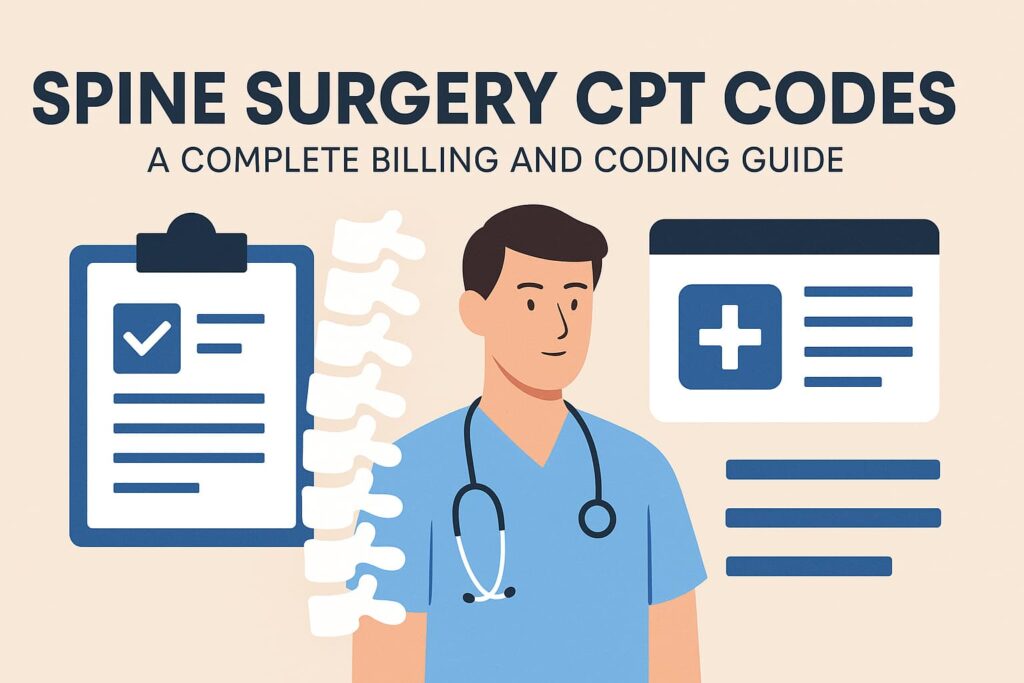Table of Contents
ToggleKey Considerations in Medical Spine Surgery Billing
Spine surgery billing requires more than just assigning procedure codes. The complexity of spinal operations, variation in techniques, and payer-specific rules demand a meticulous approach.
1. Detailed Procedure Documentation
Thorough documentation is the foundation of accurate spine surgery billing. Every billed service must be backed by operative notes that specify:
- Surgical approach (anterior/posterior/lateral)
- Levels operated (e.g., L4-L5, C5-C6)
- Instrumentation or implants used
- Additional procedures (e.g., decompression, arthrodesis)
2. Accurate CPT Code Selection
CPT code accuracy directly affects reimbursement for spine procedures. Use the most precise code for each segment and technique based on the procedure’s complexity. CPT codes often distinguish between:
- Single-level vs. multilevel surgeries
- With vs. without instrumentation
- Type of decompression (laminectomy, discectomy, facetectomy)
3. Modifier Use
Modifiers clarify the scope and specifics of spine surgery billing. Apply modifiers correctly to reflect:
- Bilateral procedures (Modifier 50)
- Multiple procedures (Modifier 51)
- Staged procedures (Modifier 58)
- Distinct procedural services (Modifier 59)
For Medicare claims, additional modifiers such as GY, GA, and GZ may apply. Read our full guide to avoid rejections.
4. Insurance and Prior Authorization
Many payers require pre-authorization for spinal surgery. Missing this step can result in claim denials. Verify:
- Medical necessity documentation
- Prior authorization number
- Coverage limitations by payer (especially Medicare vs. commercial plans)
Common Spine Surgery Procedure Codes by Region
CPT codes vary based on the spinal region, surgical technique, and complexity. Below is a categorized list of frequently billed spine surgery CPT codes used in common procedures.
Lumbar Laminectomy and Decompression Techniques:
- 63030 – Laminotomy with decompression, single interspace
- 63047 – Laminectomy, facetectomy and foraminotomy, single vertebral segment
- 63048 – Each additional segment (use with 63047)
Discectomy:
- 63030 – Laminotomy with discectomy (used also for microdiscectomy)
- 63035 – Each additional segment
Spinal Fusion (Arthrodesis):
- 22612 – Lumbar spine, single level
- 22630 – Posterior interbody fusion, lumbar, single level
- 22633 – Combined posterior fusion and decompression
- 22551 – Anterior cervical fusion, single level
- 22552 – Each additional cervical level
Instrumentation & Grafting:
- 22840 – Posterior non-segmental instrumentation
- 22842 – Posterior segmental instrumentation (2–3 vertebral segments)
- 22845–22847 – Instrumentation for 4+ segments
- 20930 – Allograft, morselized
- 20931 – Allograft, structural
Spinal Cord Stimulation & Devices:
- 63650 – Implantation of spinal neurostimulator
- 63685 – Pulse generator implantation
- 22899 – Unlisted spine procedure (used for advanced or hybrid techniques)
Understanding ICD-10 Codes for Patient Diagnosis and Coverage
ICD-10 codes must align with the documented spinal condition and the selected CPT procedure code. Use the following commonly paired examples to ensure coding accuracy:
- M48.06 – Spinal stenosis, lumbar region
- M51.26 – Other intervertebral disc displacement, lumbar
- M43.06 – Spondylolisthesis, lumbar region
- M54.5 – Low back pain
Documentation Tips for CPT Accuracy
Proper documentation underpins accurate CPT coding in spine surgery. The following tips ensure clinical notes support submitted codes effectively.
- Clearly state procedure performed, level(s) involved, and whether instrumentation or grafting was done.
- For multi-level surgeries, code each level appropriately and support with operative detail.
- Note any intraoperative complications or anatomical variants that may affect code selection or modifier use.
Common Spine Surgery Coding Errors
Even experienced coders can make costly errors when billing for spinal procedures. Below are the most frequent mistakes that lead to denials or underpayment.
- Bundling errors: Using separate codes for services included in a primary code, which is often referred to as unbundling and can lead to denials.
- Improper modifier usage: Failing to support modifier 59 or 22 with clear documentation
- Missing additional levels: Omitting + codes like 63035 or 63048
- Incorrect fusion coding: Confusing anterior vs. posterior approach or levels
Best Practices for Spine Surgery Billing
Implementing billing best practices helps ensure clean claim submission and faster payment. The following strategies support accuracy, efficiency, and compliance.
- Review payer-specific coverage policies regularly
- Train coders on new CPT guidelines and edits
- Use coding software with NCCI edit alerts
- Outsource to billing experts if needed for high-complexity claims
- Audit spine claims monthly to catch underbilling or denials
Wrapping Up Spine CPT Coding Essentials
Spine surgery CPT coding is intricate but critical for accurate reimbursement. From documentation and code selection to modifier use and payer compliance, every step impacts claim success. By mastering the most-used CPT codes, applying correct modifiers, and aligning with payer rules, providers can reduce denials and improve financial outcomes.
Need help with spine surgery billing? Contact our experts from Swift which specialize in orthopedic and neurosurgical coding and can ensure your claims are clean, compliant, and optimized for payment.




